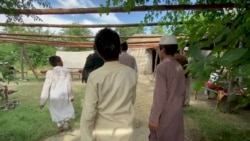“No one believed that I would be back,” said Ajar Nabi, 25, who was released by the Taliban after two years of detention. “My elderly mother hugged me and cried of happiness when she saw me.”
A resident of Achin district in eastern Nangarhar province and member of the Afghan army since 2016, Nabil was among a group of soldiers captured by the Taliban two years ago after their military headquarter in southern Uruzgan province was overrun by the group. He was a part of 420 captives released by the group on May 18.
Being a Taliban prisoner was not easy. The group kept him and other Afghan army captives in a cave complex with no connection to the outside world. During that time, he was prohibited from reaching out to his family with an exception once to see his older brother to visit him.
“There was a big corridor [inside the cave], and they were digging rooms in it. In one of the rooms, there were seven people, in another six and yet in another 19. In the room that I was in, we were eight,” he said.
Now, after two years of hardship in a Taliban prison, Nabi believes that the best course for Afghanistan is to bring a peaceful resolution to the conflict. The prisoner release initiative, he argues, is a major step forward.
The prisoner swap deal between the government and the Taliban started earlier this year as a confidence-building measure in the U.S.-Taliban peace agreement. Afghan officials in Kabul say they have so far released around 2,710 Taliban prisoners.
One of the suspected Taliban members, Zahir Osmani, was released by the government last month after spending five years in Kabul’s Pul-e-charkhi prison.
Osmani, 27, was enlisted by the Taliban among thousands of their members that needed to be freed by Kabul. However, he rejects the government accusation that he was a member of the Islamist group.
“I was not a Talib, but I can’t say that my brother was not a Talib,” said Osmani, charging that the government had arrested him in 2015 based on false accusations. “It might be because of him, because of my family or village.”
He told VOA that he received enough meals in the Kabul prison and that he was able to memorize the Quran.
Still a supporter of Taliban’s version of an Islamic government in Afghanistan, Osmani said he wanted to live as “an ordinary Afghan” in his home district of Alingar in eastern Laghman province.
Prisoner Swap
The Afghan government has not released any official data about the number of its soldiers in Taliban custody. The Taliban said that they have freed 420 captives, but the government has said that some released by the Taliban are civilians, not soldiers or government employees.
In response to the Taliban’s three-day truce during Eid-ul-Fitr, Afghan president Ashraf Ghani last week ordered the release of additional 2,000 Taliban prisoners as a good will gesture. Afghan officials have said an extended cease-fire could facilitate the release of all Taliban prisoners.
The Taliban, however, have requested the release of some 5,000 of their members by the government as a condition to begin intra-Afghan talks. The group early this week said it has dispatched a technical team to Kabul who will work with the government officials on “the verification and identification of prisoners.”
'No Guarantees'
The government has previously said that the Taliban prisoners have promised not to return to violence upon their release. Similarly, U.S. officials have said the Taliban group -- as a part of its agreement with Washington -- has agreed not to allow released prisoners to return to the battlefield.
However, some experts say they are concerned that many of the Taliban members retain loyalty to the group despite years of imprisonment.
Zabihullah Farhang, a spokesperson for Afghanistan’s Independent Human Rights Commission (AIHRC), told VOA that there was no guarantee that those released Taliban would not return to the frontlines.
“The government should provide information on whether those accused of war crimes, perpetrating violence or crime against humanity are among the released,” said Farhang, adding that the was not being transparent in sharing information on the released detainees with local watchdogs.
The Taliban, according to AIHRC spokesperson, will also need to address concerns about human rights violations in its prisons and whether the government soldiers had “enough food, medicine and other services.”
However, some experts say the vetting process in Kabul ensures only those unlikely to return to violence are released.
“The Afghan government has not released the high-ranking Taliban prisoners in its custody and still resist doing so,” said Marvin Weinbaum, the director of the Afghanistan and Pakistan Program at the Washington-based Middle East Institute.
Those released “are people who are ill or old who are less likely to be able to go back to the battlefield,” he told VOA, adding “prisoners release is supposed to be a vehicle by which you get to the intra-Afghan negotiation.”
Way Forward
Talking to reporters Monday, the U.S. envoy to Afghanistan, Zalmay Khalilzad, said that progress has been made in prisoners release and the levels of violence has remained low since Eid’s cease-fire. However, he added that more prisoners should be released ahead of peace talks.
“We are optimistic that finally we’re moving forward to the start of the intra-Afghan negotiations,” Khalilzad said.
According to the the U.S.-Taliban peace deal on February 29, intra-Afghan talks will determine “a permanent and comprehensive cease-fire” and “the future political roadmap of Afghanistan.”
The negations were supposed to start on March 10. However, disagreement over prisoner swap and continued violence continue to delay the talks.







